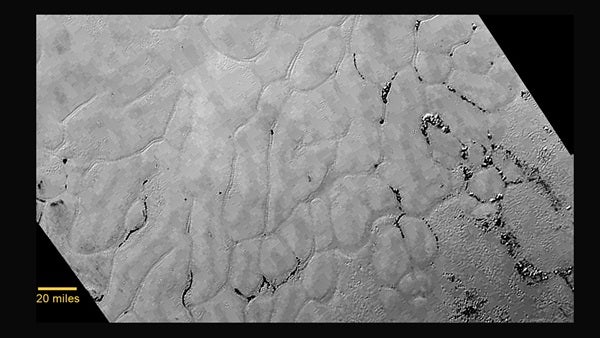The darker patch at the center of the image is likely a dirty block of water ice “floating” in denser solid nitrogen, and which has been dragged to the edge of a convection cell. Also visible are thousands of pits in the surface, which scientists believe may form by sublimation.
Transmitted to Earth on December 24, this image from the Long Range Reconnaissance Imager (LORRI) extends New Horizons’ highest-resolution views of Pluto to the very center of Sputnik Planum, the informally named icy plain that forms the left side of Pluto’s “heart” feature.
Sputnik Planum is at a lower elevation than most of the surrounding area by a couple of miles, but it is not completely flat. Its surface is separated into cells or polygons 10–25 miles (16–40 kilometers) wide, and when viewed at low Sun angles — with visible shadows — the cells are seen to have slightly raised centers and ridged margins with about 100 yards (91 meters) of overall height variation.
Mission scientists believe the pattern of the cells stems from the slow thermal convection of the nitrogen-dominated ices that fill Sputnik Planum. A reservoir that’s likely several miles deep in some places, the solid nitrogen is warmed at depth by Pluto’s modest internal heat, becomes buoyant and rises up in great blobs and then cools off and sinks again to renew the cycle.
“This part of Pluto is acting like a lava lamp,” said William McKinnon from Washington University in St. Louis, “if you can imagine a lava lamp as wide as and even deeper than Hudson Bay.”
Computer models by the New Horizons team show that these blobs of overturning solid nitrogen can slowly evolve and merge over millions of years. The ridged margins, which mark where cooled nitrogen ice sinks back down, can be pinched off and abandoned. The “X” feature is likely one of these — a former quadruple junction where four convection cells met. Numerous, active triple junctions can be seen elsewhere in the LORRI mosaic.










